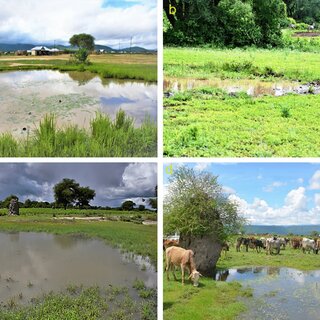Environmental risks posed by widespread pesticide application have attracted global attention. Currently, chemical risk assessments in aquatic environments rely on extrapolation of toxicity data from classic model species. However, similar assessments based on local species could be complementary, particularly for unusual living environments such as temporary ponds. Here, we carried out an environmental risk assessment (ERA) of a pyrethroid model compound, cypermethrin, based on local temporary pond species. First, we measured cypermethrin residue concentrations in rivers, irrigation canals and temporary ponds in the Lake Manyara Basin (LMB). Then, we estimated the environmental risks of cypermethrin by combining these data with acute toxicity data of three resident species across three trophic levels: primary producers (Arthrospira platensis), invertebrate grazers (Streptocephalus lamellifer) and fish (Nothobranchius neumanni). Furthermore, we compared the derived ERA to that obtained using toxicity data from literature of classic model species. Cypermethrin residue concentrations in contaminated systems of the LMB ranged from 0.01 to 57.9 ng/L. For temporary pond species, S. lamellifer was the most sensitive one with a 96 h-LC50 of 0.14 ng/L. Regardless of the assumed exposure concentration (0.01 and 57.9 ng/L), the estimated risks were low for primary producers and high for invertebrate grazers, both for local species as well as for classic model species. The highest detected cypermethrin concentration resulted in a moderate risk estimation for local fish species, while the estimated risk was high when considering classic fish models. Our results confirm that, at least for pyrethroids, ERAs with classic model species are useful to estimate chemical risks in temporary pond ecosystems, and suggest that complementary ERAs based on local species could help to fine-tune environmental regulations to specific local conditions and conservation targets.
For more information CLICK HERE




